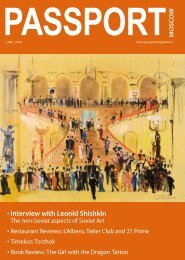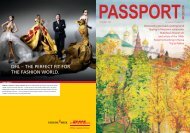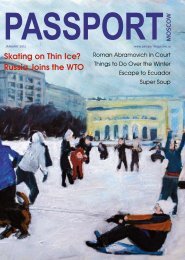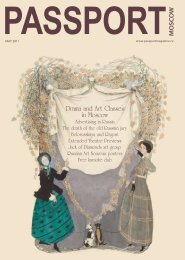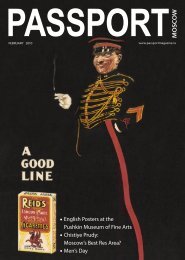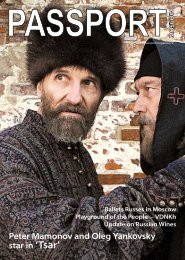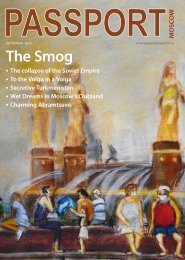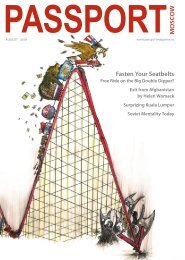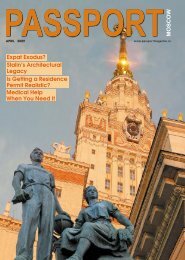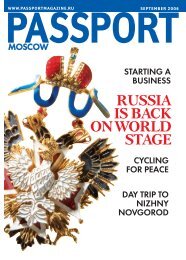You also want an ePaper? Increase the reach of your titles
YUMPU automatically turns print PDFs into web optimized ePapers that Google loves.
Hunt for painted<br />
prisoners of war<br />
Helen Womack<br />
In 1992, the hunt was on for so-called<br />
“Trophy Art”, paintings and other artifacts<br />
that Soviet forces looted from Berlin<br />
at the end of World War II. Had the<br />
treasures all been German, the scandal<br />
might not have been so great. But many<br />
were European masterpieces that the<br />
Nazis had grabbed from collections in<br />
occupied countries, such as Holland.<br />
The West hoped that newly independent<br />
Russia would come clean about<br />
the hidden pictures and return them to<br />
their rightful owners.<br />
Two art historians, Konstantin Akinsha<br />
and Grigory Kozlov, first blew the whistle<br />
on Russian museums that were holding<br />
the treasures in dark vaults, keeping them<br />
from public view. The authorities flatly denied<br />
that thousands of priceless works by<br />
artists from Durer and Rembrandt to Goya<br />
and Manet were in Russia, having been<br />
taken from Berlin by Stalin’s special confiscation<br />
squads, as well as ordinary soldiers<br />
helping themselves to “souvenirs”.<br />
I got a tip-off that the long-lost Koenigs<br />
Collection of Old Master drawings,<br />
sold under duress to the Nazis by a<br />
Rotterdam museum, was being kept at<br />
Glebov’s House, home to the Pushkin<br />
Museum’s department of graphics.<br />
“Oh yes, they’re here, they’re definitely<br />
here,” a young curator told me pleasantly.<br />
“I’ll just fetch the Dutch expert for you.”<br />
Two minutes later, the woman returned<br />
with a stony face and said: “No, there’s<br />
nothing here. You misunderstood.”<br />
I felt the thrill of the chase.<br />
The story developed when a video<br />
came to light, showing 17th and 18th century<br />
French paintings hanging at Uzkoye,<br />
a sanatorium on the edge of Moscow enjoyed<br />
by scientists from the Academy of<br />
Sciences. I went to the estate, which had<br />
once belonged to Prince Trubetskoy, and<br />
pretended an interest in the Russian aristocracy.<br />
The manager wouldn’t let me in,<br />
for fear of disturbing the scientists, but<br />
she did walk with me in the grounds.<br />
She volunteered the information that<br />
the local church contained rare books<br />
from German libraries. “Oh really,” I<br />
said, “and I’ve heard that you also have<br />
French paintings in the main house.”<br />
She was aghast. “Where did you get that<br />
information from? I don’t like the look of<br />
1992<br />
this. There’s too much interest in those<br />
pictures. I won’t tell you anything.”<br />
That really whetted my appetite.<br />
Then Akinsha and Kozlov came up with<br />
documentary proof that ancient gold, excavated<br />
from the site of Troy by the 19th<br />
century German archaeologist Heinrich<br />
Schliemann and before the war exhibited<br />
in Berlin, was among the plundered treasures<br />
in Moscow. They gave me access<br />
to the inventory that accompanied the<br />
crates of gold from Germany and a paper<br />
confirming receipt in Moscow, signed by<br />
a certain Lapin on 9 July 1945.<br />
This was dynamite. And still the authorities<br />
were denying everything. Of<br />
course, I was desperate to find some<br />
trophy art myself.<br />
By chance, I attended a wedding. It<br />
was a fashionable affair and the bride<br />
and groom, film makers with an eye for<br />
Soviet kitsch, had hired a Palace of Culture<br />
in the countryside outside Moscow<br />
for their reception.<br />
The guests mingled among potted<br />
palms or played billiards in what was effectively<br />
a country club. I wandered into<br />
a ground floor sitting room and saw two<br />
fine landscapes hanging on the wall.<br />
I didn’t recognise the pictures but<br />
asked the director, a cheerful old Communist<br />
called Vladimir Davidov, where<br />
they came from. “Oh, that’s trophy art,<br />
taken from Germany at the end of the<br />
war,” he said without batting an eyelid.<br />
“I got them from Uzkoye when this club<br />
was built in 1954 and we needed something<br />
to decorate the walls.”<br />
He allowed me back to photograph<br />
the paintings, which were later identified<br />
by experts as Vespasian’s Temple in<br />
Rome and The Narni Valley by Wilhelm<br />
Schirmer, a German romantic artist who<br />
lived in Italy in the 19th century.<br />
It was becoming difficult for the Russian<br />
authorities to stonewall any longer.<br />
And they had their point of view,<br />
too. The Nazis had destroyed much of<br />
Russian cultural heritage during their<br />
occupation of Soviet territory. Russian<br />
treasures, such as icons, that had found<br />
their way to Germany had been sold<br />
on the open market, making it virtually<br />
impossible that they would ever be<br />
returned. Surely Russia deserved some<br />
compensation, they said.<br />
The Way It Was<br />
In October 1992, the Russian Culture<br />
Minister, Yevgeny Sidorov, admitted the<br />
existence of the trophy art and invited<br />
the Dutch ambassador, Joris Vos, to see<br />
the Koenigs Collection.<br />
It would be another three years before<br />
the Pushkin Museum put on an<br />
exhibition of trophy art entitled Saved<br />
Twice Over. Director Irina Antonova<br />
said the world should be grateful to the<br />
confiscation squads who “saved” the<br />
paintings from the ruins of Berlin, handing<br />
them over to museum staff, who<br />
“saved” them again through painstaking<br />
restoration.<br />
Did the trophy art then go back to<br />
Western Europe? In fact, not; most of it<br />
is still in Russia. In 2004 Ukraine, which<br />
was holding half of the Koenigs Collection,<br />
did return its drawings to The<br />
Netherlands but the rest remain in the<br />
Pushkin Museum in Moscow, their fate<br />
still “under consideration” by a very<br />
slow-moving Russia. P<br />
January 2011<br />
1



